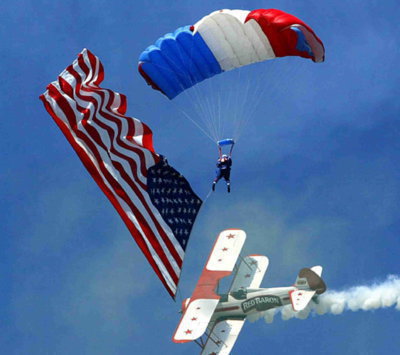Recommended Posts
dpreguy 14
2) 'people asking for major corrections to the jump run (shorter, change in heading) as the plane approaches or turns in on jump run'
Well, you are correct on "major" corrections, but I would argue that usually the only time to alter the change in heading, or shortening or lenghtening the exit point IS on the beginning of, or during the jump run. That is the first time the plane is flying straight and level and the target can be viewed by the jumpmaster in relationship to the aircraft's movement. I agree this is no time for major corrections, but; when I see the plane barely making headway and I want the load to get out later (extend the spot); or if the plane is drifting left or right a lot, and I want to have a 10 or 15 degree change in heading to compensate for freefall drift and being over the exit point that is intended, I don't want any backtalk from the pilot. Of course, if the jumpmaser (for want of a better term) sees the canopies of the load before having to crab all of the time or to hold or run just to get to the landing area, before the plane takes off, then he can tell the pilot to make changes prior to takeoff, but, in the normal situation, where the JM is getting his first look at the situation, and the plane is drifting in relationship to the ground or an adjustment is called for on shortening or lengthening the exit; I expect the pilot to execute and be quiet. So, maybe the defintion of "major" is the point here, but, unlesss the pilot has a gps unit that tells him when the plane is drifiting or the ground speed, and when the pilot notices that AND KNOWS WHAT TO DO ABOUT IT when he sees this, then he should defer to the guy looking out the door. I expect the pilot to accept my request to "Lenghten the exit by 1/4 mile" or if there is a GPS to "Extend the exit two clicks" or "10 left". or "Offset the jump run to the left by one click". Yes the pilot is in command - PIC, but his job is to deliver the jumpers to a good exit point
I guess all know that a GPS's are read as one tenth of a nautical mile of 6000 feet. Therefore, one click means one tenth of a nautical mile which is 600 feet.
So, if the JM says to "Extend the exit point by two clicks", he means to extend it by 1200 feet roughly /a quarter of a mile. Or "Offset the jump run to the left by one click" it means to fly the jump run in a straight line 600 feet to the left of the previous jump run. I have never (OK maybe never is too strong) had a problem with a pilot doing any of this, but this comment is to avoid the pilot having the mindset that a jump run should never be changed. Sometimes it should be. And if it is changed, the pilot shouldn't have an attitude about it.
Ideally, if the pilot has a GPS gizmo, and notices the groundspeed being way way slow or fast, or he notices the plane drifitng left or right , and reacts by flying to correct drift or turning on the exit light sooner or later these discussions are unnecesary. But, expecting to fly the same jump run all day, and being irritated when he hears a request, is a bit arrogant. Hence some of the stories and gripes I have heard over many years. I haven't had problems, but others have.
Well, you are correct on "major" corrections, but I would argue that usually the only time to alter the change in heading, or shortening or lenghtening the exit point IS on the beginning of, or during the jump run. That is the first time the plane is flying straight and level and the target can be viewed by the jumpmaster in relationship to the aircraft's movement. I agree this is no time for major corrections, but; when I see the plane barely making headway and I want the load to get out later (extend the spot); or if the plane is drifting left or right a lot, and I want to have a 10 or 15 degree change in heading to compensate for freefall drift and being over the exit point that is intended, I don't want any backtalk from the pilot. Of course, if the jumpmaser (for want of a better term) sees the canopies of the load before having to crab all of the time or to hold or run just to get to the landing area, before the plane takes off, then he can tell the pilot to make changes prior to takeoff, but, in the normal situation, where the JM is getting his first look at the situation, and the plane is drifting in relationship to the ground or an adjustment is called for on shortening or lengthening the exit; I expect the pilot to execute and be quiet. So, maybe the defintion of "major" is the point here, but, unlesss the pilot has a gps unit that tells him when the plane is drifiting or the ground speed, and when the pilot notices that AND KNOWS WHAT TO DO ABOUT IT when he sees this, then he should defer to the guy looking out the door. I expect the pilot to accept my request to "Lenghten the exit by 1/4 mile" or if there is a GPS to "Extend the exit two clicks" or "10 left". or "Offset the jump run to the left by one click". Yes the pilot is in command - PIC, but his job is to deliver the jumpers to a good exit point
I guess all know that a GPS's are read as one tenth of a nautical mile of 6000 feet. Therefore, one click means one tenth of a nautical mile which is 600 feet.
So, if the JM says to "Extend the exit point by two clicks", he means to extend it by 1200 feet roughly /a quarter of a mile. Or "Offset the jump run to the left by one click" it means to fly the jump run in a straight line 600 feet to the left of the previous jump run. I have never (OK maybe never is too strong) had a problem with a pilot doing any of this, but this comment is to avoid the pilot having the mindset that a jump run should never be changed. Sometimes it should be. And if it is changed, the pilot shouldn't have an attitude about it.
Ideally, if the pilot has a GPS gizmo, and notices the groundspeed being way way slow or fast, or he notices the plane drifitng left or right , and reacts by flying to correct drift or turning on the exit light sooner or later these discussions are unnecesary. But, expecting to fly the same jump run all day, and being irritated when he hears a request, is a bit arrogant. Hence some of the stories and gripes I have heard over many years. I haven't had problems, but others have.
We BOTH know a silver haired demo jumpin' d00d that has time & again called for 5-left.....then.....5-right! ![]()
![]()
![]() I think we were BOTH laughin' when he did it in Wis. this summer!
I think we were BOTH laughin' when he did it in Wis. this summer!
Fill out your 'profile' H.W., ~![]()
'I' know the experience & authority with which you speak, but a lotta the others on here might be amazed to see someone still cranking 'em out ...who's been 'Knees in the Breeze' three times longer than even me! ![]()
~Ya old fart! ![]()
~ If you choke a Smurf, what color does it turn? ~
dpreguy 14
OK I'm busted
JohnRich 4
QuoteWe BOTH know a silver haired demo jumpin' d00d that has time & again called for 5-left.....then.....5-right!
There are a couple of circumstances where that can be perfectly legit.
One would be if you realize after the first command that it was a mistake, and you want to go back to where you were. The spotter should swallow their pride and make the proper correction. They should not continue on a bad line because they're too embarassed to admit they made a bad call.
The second would be if you need to offset the jump run to one side a bit. By going 5-left for a while and then getting back on the original track with a 5-right, you have moved the jump run laterally. And that is sometimes needed when the track is off to one side too far.
I know you know all this, but I thought I'd throw this out there for others.
QuoteQuoteWe BOTH know a silver haired demo jumpin' d00d that has time & again called for 5-left.....then.....5-right!
There are a couple of circumstances where that can be perfectly legit. .
All too true. Been there, done that on both instances.
Well, mine was early on jump run, "5-left! Oooops! Now go back 10 right!"
Pilot later asked..."Are you sure you know your right from your left?"
BTW, we ended up on-target and all had great a great spot....even the one that had cutaway a D5 and landed his Lo-Po in the peas.
My reality and yours are quite different.
I think we're all Bozos on this bus.
Falcon5232, SCS8170, SCSA353, POPS9398, DS239
I think we're all Bozos on this bus.
Falcon5232, SCS8170, SCSA353, POPS9398, DS239
craigbey 0
We're on the same page.
I was referring to major or significant changes to the start of the jumprun or the jumprun heading based on the outcome of the spot from prior loads and how / when such a request gets communicated to the pilot -- my first point.
Obviously, this type of request should be communicated well before the plane gets to jumprun or on the ground.
I was referring to major or significant changes to the start of the jumprun or the jumprun heading based on the outcome of the spot from prior loads and how / when such a request gets communicated to the pilot -- my first point.
Obviously, this type of request should be communicated well before the plane gets to jumprun or on the ground.





Not dumb, but perhaps just not yet aware of protocol / etiquette?
1) people who don't know or can't recognize when it is good / bad to try to speak with the pilot
2) people asking for major corrections to the jump run (shorter, change in heading) as the plane approaches or turns on to jump run
3) people spotting for themselves or their group from a larger plane (e.g. Otter) after the light comes one and screwing up the spot / jumprun
4) people making excessive noise -- or stink -- in the plane
I have met some pilots who may not immediately seem 'warm and friendly' or particularly chatty in the plane, but they're some of the best in the business because they're focused on that business. I like to let them do their job.
Share this post
Link to post
Share on other sites